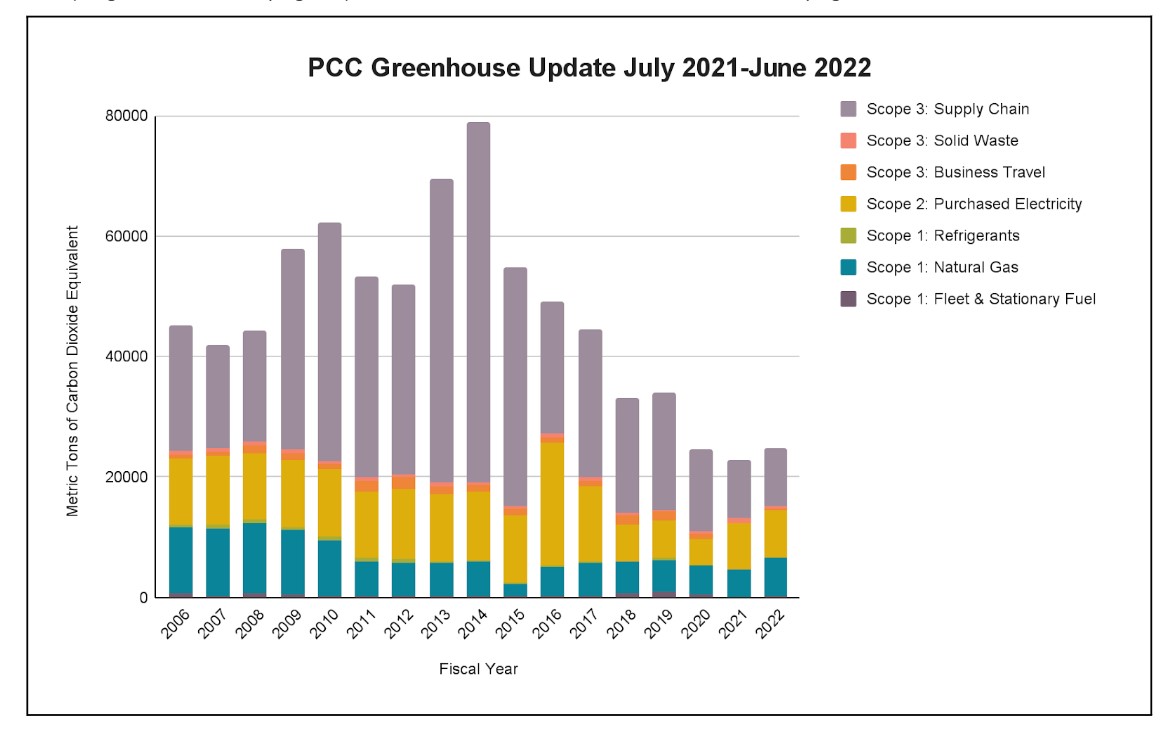GHG Inventory Update 2022
Overview
The Portland Community College Sustainability Department completes an annual greenhouse gas (GHG) inventory to monitor our institution’s progress towards meeting our GHG reduction targets as outlined in PCC’s 2021 Climate Action Plan: Resiliency, Equity and Education for a Just Transition.
The 2021 update set a new target date of 2040 for Carbon Neutrality from Scope 1 & 2 emissions. Using science-based targets as the model for reduction, PCC took the available information on the college’s emissions and aligned the reduction targets so that PCC’s contribution to limiting global warming would not exceed 1.5°C. In support of equitable climate action, PCC must work to limit climate change contributions in alignment with a global need for GHG emissions not to exceed 1.5°C, which is the threshold scientists have identified to protect many low-lying and island nations from disastrous sea level rise.
In addition to setting new carbon neutrality targets, the plan outlines five-year goals to be met in the areas of all Scope 1 and 2 GHG emissions, currently tracked Scope 3 GHG emissions, education and outreach and resiliency. Equity is embedded throughout PCC’s Climate Action Plan.
About PCC’s Greenhouse Gas Emissions
PCC’s greenhouse gas emissions are influenced by student and educational needs, building and systems design, fuel choices, operational efficiency, and individual behaviors such as purchasing and commuting choices. We look at our emissions in terms of the amount of direct influence we have and divide them by scope accordingly.
Our Scope 1 & 2 emissions chiefly consist of emissions from heating and lighting buildings and running electrical equipment. It is also where PCC has the greatest opportunity to influence change, through green building design and improvements in operations, energy efficiency, and education and outreach.
Our Scope 3 emissions are more challenging to both measure and influence. They include emissions from commuting to the college by both staff and employees, college purchases of goods and services and from business travel. Because of their indirect nature, both supply chain emissions and commuting emissions have unique challenges in terms of measuring change. While we have undertaken many significant projects to reduce the emissions from our supply chain through greener purchasing, supply chain emissions are chiefly measured by spending and it is difficult to separate green spending from non-green spending at this time. Furthermore, commuting emissions tend to fluctuate with student enrollment and while significant commuters utilize alternative transportation, the sheer number of people commuting to campus each day overshadows this.
Greenhouse Gas Emissions Inventory
Operating Buildings and Grounds (Scope I and II Emissions) Highlights
- Between 2006 and 2022, we reduced our emissions at PCC from operating our Buildings and Grounds (Scope 1 & 2 emissions) by about 35.6% with net emissions of 14,771 metric tons of carbon dioxide equivalent (MTCO2E) compared to 22,959 MTCO2E in 2006 and 12,682 MTCO2E in 2019, our last full year of reporting prior to the pandemic.
- In FY 2022, the college received approximately 5,945,000 kWh in renewable energy credits, which reduced the college’s carbon footprint by 1,872 MTCO2E, due to its subscriptions toPortland General Electric’s Renewable Energy Credit programs Green Future Enterprise and Green Future Impact as well as Oregon Shine’s Community Solar program. When all of the facilities from these programs are completed in the late summer of 2023, the college expects to achieve net annual average savings of about $19,083 for the next twenty-two years.
- Overall, we’ve decreased our total building energy consumption use per square foot by about 51%. PCC’s innovative investment in LEED certified green buildings, lighting upgrades, and behavior change programs such as Power Shift and Panther Print have historically helped to reduce energy use and climate change impacts; however, an increase in the use of outside air due to COVID-19 contributed greatly to an increase in the use of natural gas, which substantially reduced our energy savings in FY 2022.
Travel, Commuting, Purchasing, and Solid Waste (Scope III Emissions) Highlights
Overall Scope 3 emissions still made up the largest share of PCC’s emissions at 58%. Scope 3 emissions are tightly tied to commuting and purchasing, both of which historically shift with our student enrollment levels.
The largest contributor to Scope 3 emissions in FY 2022 were commuting emissions, which made up about 28% of the Scope 3 emissions, while emissions from purchases (aka our supply chain) made up the majority of the remainder of Scope 3 emissions at nearly the same amount. Business travel and solid waste combined made up less than 3% of the remaining emissions. Commuting, business travel and solid waste were still significantly reduced due to the ongoing pandemic. While some on-campus learning began to take place in the spring of 2021; the college did not resume normal operations until the Fall of 2022. (We used a shortened number of days for commuting per year to 60 for FY 2022, which is about ⅓ of pre-pandemic numbers.) Furthermore, many more people are working and attending school remotely at least two days a week.
Purchasing and waste habits also impact scope 3 emissions. The Sustainability Department is working closely with the Purchasing Department and other college buyers to advance sustainable purchasing practices. While we saw a reduction in waste-related emissions, it’s important to recognize that more students are taking courses on-line and overall enrolment is down. In turn, from student-facing areas such as Dining Services which in turn leads to reduced on-campus waste.
Future Greenhouse Gas Emissions Reduction
The college is working on a wide variety of initiatives to reduce our greenhouse gas footprint. Many of these efforts are outlined in PCC’s 2021 Climate Action Plan: Resiliency, Equity, and Education for a Just Transition and Sustainability Leadership Council annual work plans. If you would like to learn more or are interested in getting involved, email sustainability@pcc.edu.

